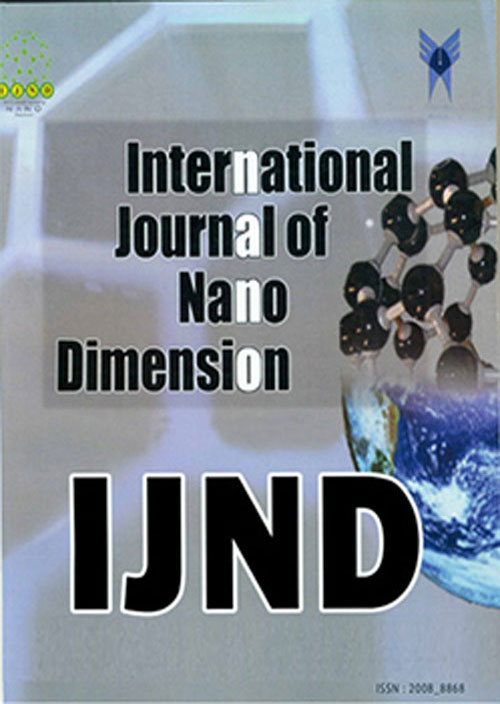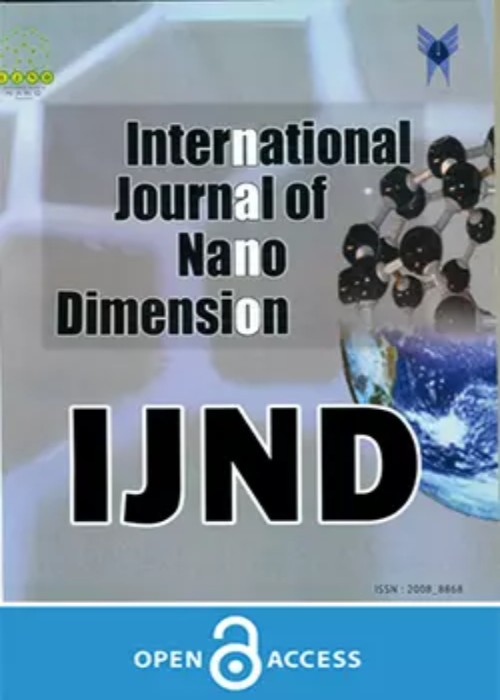فهرست مطالب

International Journal of Nano Dimension
Volume:12 Issue: 2, Spring 2021
- تاریخ انتشار: 1400/01/29
- تعداد عناوین: 10
-
-
Pages 90-97
Green chemistry is the pragmatism of a set of principles, which eliminate the use or production of hazardous substances in the design, development, synthesis and applications of chemical harvest. Accordingly, green synthetic techniques aim at hazard reduction as the recital criteria, whilst designing new chemical processes/methods. Catalysis lies at the heart of all chemical processes and hence, nanocatalysts with particle size dependent material engineering are of significant interest towards green chemistry and clean energy applications. In addition to particle size, nanostructured catalysts are exceedingly shape and/or morphology sensitive and their catalytic performance depend largely on their shape and morphology. Besides, nanocatalysts empowered with colossal surface areas, excellent recycling potential and efficient recovery characteristics are heralded as new process candidates with expanding catalytic capabilities. Accordingly, recapitulation of the synthesis of several new types of chemical entities is using nano-catalysts in the heterocyclic ring formation and some other important functionalization.
Keywords: Catalysis, Catalytic applications, Characterization, Green synthesis, Nano-catalyst -
Pages 98-103In this article, the high-k gate dielectric effect on the operation of complementary metal oxide semiconductor (CMOS) inverter build using conventional (CL) double-gate (DG) metal oxide semiconductor field effect transistor (MOSFET) and junctionless (JL) double-gate (DG) MOSFET has been explored. It is found that the improvement in inverter performance is more pronounced in CL-DG-MOSFET based CMOS inverter in comparison to JL-DG-MOSFET based CMOS inverter when SiO2 is replaced by the high-k dielectric at gate oxide. The improvement in low noise margin (ΔNML), high noise margin (ΔNMH), gain (ΔA) & propagation delay (Δp < sub>d) is 3.19%, 1.64%, 5.2% & 0.9% respectively when SiO2 is replaced by TiO2 at gate oxide in case of CL-DG-MOSFET based CMOS inverter whereas it is 1.96%, 1.24%, 3.4% & 1.71% respectively in case of JL-DG-MOSFET based CMOS inverter. Consequently, the utilization of high-k dielectric as gate oxide is more advantageous in CL-DG-MOSFET devices for improved stability and gain of CMOS inverter.Keywords: CMOS Inverter, DG-MOSFET, Gate-Stack, High-k, Junctionless
-
Pages 104-112
This article reports an experimental study of heat transfer characteristics of multi-walled carbon nanotubes (MWCNTs). These nanofluids, consisting of water with different weight concentrations of nanofluid (0.0.1–0.145% wt.), have flown in counter flow plate heat exchanger under turbulent conditions (the range of Reynolds numbers 2500-6500) for cooling applications. The nanofluid was prepared by dispersing MWCNT nanoparticles in the presence of sodium dodecyl sulfate (SDS) and water as base fluid. The results showed that the convective heat transfer coefficient (HTC) of nanofluid was higher than that of the base fluid at an equal mass flow rate and inlet temperature. The heat transfer coefficient of nanofluid increased by mass flow rate and temperature rising. Also, the heat transfer coefficient and the concentration of MWCNTs nanofluid showed a positive association at the same temperature. At a constant weight concentration, the heat transfer coefficient increased when the Reynolds number increased. The slope weight concentration tended to rise as the heat transfer coefficient growing. The increase in Reynolds numbers (or mass flow) was less than the increase in the concentration of carbon nanotubes. According to the performed experiments and software analysis (QUALITEK 4), the heat transfer coefficient and concentration both multiplied at the same time. But there was an inverse relationship between the heat transfer coefficient and flow rate.
Keywords: Heat Transfer Coefficient, MWCNT, Optimization, Software, surfactant -
Pages 113-127In this study, a new and effective catalyst was prepared by supporting the α-Fe2O3 nanoparticles on a metal-organic framework (MOF). The synthesis of nano α-Fe2O3 photocatalyst was performed according to the reflux condensation method. The MOF was synthesized using cadmium nitrate and terephthalic acid. The nano α-Fe2O3 stabilized on the MOF by the solid-state distribution method. The α-Fe2O3/MOF was characterized by FTIR, XRD, SEM, EDX, TEM, N2 adsorption-desorption, and TGA techniques. The α-Fe2O3/MOF was used as a catalyst to the UV/H2O2 photocatalytic decomposition of Cefalexin (CFX) in the aqueous solutions. This process was optimized and modelled using the full factorial experimental design. Initial concentrations of CFX, pH, α- Fe2O3/MOF amounts, and initial concentration of H2O2 were the variables for determining the optimal conditions and mathematical model. The highest decomposition percentage of CFX was 95.84%. The kinetics of this reaction was obtained pseudo-first-order at a constant rate of 0.0769 min-1.Keywords: α-Fe2O3, Cefalexin, Metal-organic framework, Photocatalyst, Solid-state distribution
-
Pages 128-134This study investigates the possible effects of iron oxide nanoparticles (FeNPs) on plant growth, expression of bZIP, DREB, and WRKY1, and biofortification efficacy in wheat (Triticum aestivum). The seedlings were treated with bulk iron oxide (bulk-Fe) or FeNPs at 100, 200, 300, and 400 mgL-1. FeNPs significantly improved the fresh and dry weights of shoot and root compared to the control. Likewise, different concentrations of bulk-Fe caused an increase in biomass accumulation in shoot and root. Moreover, Fe content was increased in response to the foliar application of FeNPs and bulk-Fe. The expression of bZIP, DREB, and WRKY1 in the FeNP-treated plants was markedly up-regulated compared to the control. The increase in Fe contents and biomass, as well as upregulation in bZIP, DREB, and WRKY1 genes, indicate that FeNPs could be a promising strategy to encounter iron deficiency in the human diet and to improve plant protection against biotic and abiotic stress conditions.Keywords: bZIP, DREB, Iron oxide nanoparticles, Plant nutrition, Transcription Factor, Triticum aestivum, WRKY1
-
Pages 135-144Density functional theory (DFT) approach was employed to investigate relaxation processes of each of pyrimidine nucleobases (NBs); cytosine (C), thymine (T) and uracil (U), at the Cubane Cluster Surface (CCS). The main idea was about providing a material for recognition of NBs, in which a nanostructure form of cubane (CCS) was first generated by optimization process. In the next step, relaxation processes of each of NBs at the surface were investigated to examine the function of such system for NBs recognition. The results indicated that the electronic based molecular properties could work as proper parameters for recognizing such molecular system, in which energy gap (EG) could be referred for the purpose. Measuring EG could help to recognize the complexes of CCS-C, CCS-T and CCS-U from each other. Strength of such complex formations was investigated using values of binding energy (BE); CCS-U > CCS-C > CCS-T. Total results of EG, BE and additional atomic scale properties indicated that the investigated CCS could work very well to recognize U as the characteristic NB of RNA.Keywords: cluster, Cubane, DFT, Nucleobase, recognition
-
Pages 145-155Metallic nanoparticles synthesised via green synthetic route have been proved to be detrimental against pathogens. An attempt was made to synthesise copper nanoparticles (EcS-Cu NPs) using the root extract of Echinops sp., Ethiopian medicinal plant. The most advanced techniques were employed to characterize the NPs. The presence of absorbance maxima, λmax at 454 nm confirms the formation of EcS-Cu NPs. The role of biomolecules as capping agents for EcS-Cu NPs was authenticated by FT-IR spectra. The presence of a single weak peak in the XRD pattern of NPs confirmed amorphous nature of NPs. The purity of the NPs was corroborated by SEM-EDAX analysis. TEM-HRTEM-SAED analysis authenticated the presence of partially crystalline natured copper NPs with the appearance of weak concentric SAED rings. The EcS-Cu NPs showed significant synergistic antibacterial influence verses S. aureus, E. coli, P. aeruginosa, and E. aerogenes. The uppermost zone of inhibition of 13 mm was inscribed against S. aureus bacteria. EcS-Cu NPs exhibited better antibacterial activities against gram positive and gram negative bacteria.Keywords: Amorphous, Biomolecules, Green synthesis, Medicinal Plants, Pathogens
-
Pages 156-163
In this work, the quantum mechanics calculations were carried out to elucidate the adsorption behavior of some corticosteroid drugs (clobetasol, beclometasone, prednisolone, and methylprednisolone) on the surface of C60 nano-fullerene using density functional theory (DFT) at B3LYP/6-31G (d,p) level. After optimization of the structures, various parameters such as HOMO and LUMO energies, energy gap, adsorption energy, cohesive energy, chemical hardness, chemical potential, dipole moment, electrophilicity index and changes in the length of some bonds data were calculated. The results showed that the amounts of energy gap and chemical hardness are decreased with binding of corticosteroids to fullerene, while those of chemical potential and electrophilicity index are increased. It means that nanocarrier increases the drug reactivity. Also, binding and stabilization energies are increased. The C60-Clobetasol, C60-Beclometasone, C60-Prednisolone and C60-Methylprednisolone presented the adsorption energy with the values of 54.3478, -6.5263, 45.1586, and 947.8854 KJ in gas phase, respectively. Moreover, the solubility of nanocarrier has increased in the water solvent compared to the gas phase. These results can be considered in pharmacy for these types of drugs and similar systems. The presence of oxygen atoms in the structure of drugs increases the ability of nano-fullerene as a drug carrier, because the ability of nitrogen atoms to protonation in acidic environment weakens their binding to fullerene in the target cell.
Keywords: Adsorption energy, Chemical potential, Cohesive Energy, Density functional theory (DFT), Energy gap -
Pages 164-174In this study, an inverse trigonometric nanobeam theory is applied for the bending, buckling, and free vibration analysis of nanobeams using Eringen’s nonlocal theory. The present theory satisfies zero shear stress conditions at the top and bottom surfaces of the nanobeam using constitutive relations. Equations of motion are derived by applying Hamilton’s principle. The present theory is applied for the analysis of functionally graded material nanobeams. All problems are solved by using the Navier technique. For the comparison purpose, the numerical results are generated by using the third shear deformation theory of Reddy, first-order shear deformation theory of Timoshenko, and classical beam theory of Bernoulli-Euler considering the nanosize effects. The present results are found in good agreement with those of higher order theories.Keywords: Bending, Buckling, Eringen’s Nonlocal Theory, FG Nanobeam, Trigonometric Nanobeam Theory, Vibration
-
Pages 175-185The seed extract of Spondia mombins was used in the biofabrication of silver nanoparticles (AgNPs) in this study. The biosynthesized AgNPs was characterised using UV-Vis Spectroscopy, FTIR, FESEM, TEM, XRD and EDX. The antimicrobial efficacy of the synthetized AgNPs was evaluated against certain pathogens. The absorption spectrum peaked at 425 nm when the UV analysis was carried out, with a large peak of 3000 to 3800 cm−1 indicating different functional groups on the AgNPs surface when the FTIR analysis was conducted. An examination of FESEM and TEM showed a number of spherical particle structures ranging from 10-50 nm. XRD analysis also confirmed this size range. The AgNPs synthesized inhibited growth of the microorganisms used in this study. This study demonstrates that Spondia mombins’s seed extract has biomolecules that helped to bio reduce and stabilize the AgNPs synthesized, hence confirming the possibility of using Spondia mombins seeds in AgNPs synthesis.Keywords: Antibacterial, Extraction, Green synthesis, silver nanoparticles, Spondia Mombins


